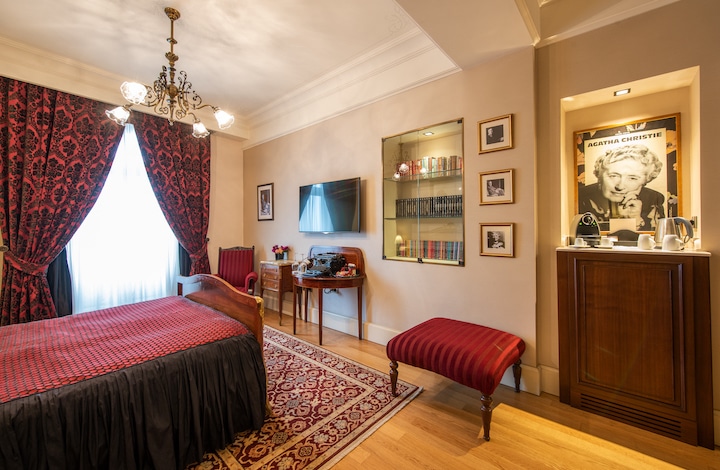
Agatha Christie may have checked out of the Petra Palace, but her presence still inhabits Room 411. Although the room serves as a shrine to Christie, it’s still possible to stay there. You may sense her spectral presence, but you won’t find Christie’s room key. It was discovered beneath a floorboard back in 1979 by an American psychic.
By Nancy Wigston
Chances are, wherever you travel, you’ll find an Agatha Christie paperback. With eighty detective novels and story collections to her name, Christie’s work has been translated into 130 languages and ranks third in sales behind the Bible and Shakespeare.
Beautiful in her youth, tweedy in middle age, Agatha Christie was from Torquay Devonshire, a seaside resort famous for Devon cream teas. While working in an English hospital dispensary, she learned about deadly poisons. She also came into contact with Belgian refugees fleeing war-torn Europe. One of whom inspired the character of dapper detective, Hercule Poirot. In 1917, her head full of potential plots, this tall, upper middle-class woman decided to try her hand at crime fiction.
Written during the war and published in 1920, her debut novel, The Mysterious Affair at Styles, introduces Poirot, a brilliant foreigner displaced by war. He unmasks the devious plotters behind a wealthy woman’s murder by strychnine. Six years later, Agatha blindsided readers with the killer’s identity in The Murder of Roger Ackroyd, her first bestseller.
Then, on December 3, 1926, Agatha Christie disappeared.
The Mystery Writer’s Mystery
This episode reads curiously like a mystery plot. A handsome, decorated English pilot who returned from the war finds his marriage faltering. He demands a divorce. There is another, younger woman. The husband then leaves to spend the weekend with friends and his new love.
Shocked by the betrayal, the wife removes her wedding ring, then drives away from their country home. The next morning a passing “gypsy boy” notices an abandoned Morris coupe, lights on, door open, near a watering hole called Silent Pond. Authorities discover some clothing and identification. The missing woman is Agatha Christie.
Agatha had always avoided the publicity attending her increasing fame. Ironically, the depression that followed her mother’s death in April 1926, followed by the breakdown in her marriage, plunged her into the national spotlight. As hundreds of police dragged Silent Pond and combed the surrounding countryside, newspapers had a field day speculating about the missing mystery writer. Suicide was suspected. So was murder. “They think I’ve killed my wife,” complained Archie Christie to a friend.
Eleven days later, Archie, accompanied the police, arrived at the elegant Hydropathic Spa Hotel (today’s The Old Swan) in Harrogate, Yorkshire, where Agatha, rejuvenated by spa treatments and gin cocktails, was checked in under the surname of Archie’s mistress. “Christie Found, Memory Gone,” blared one headline.
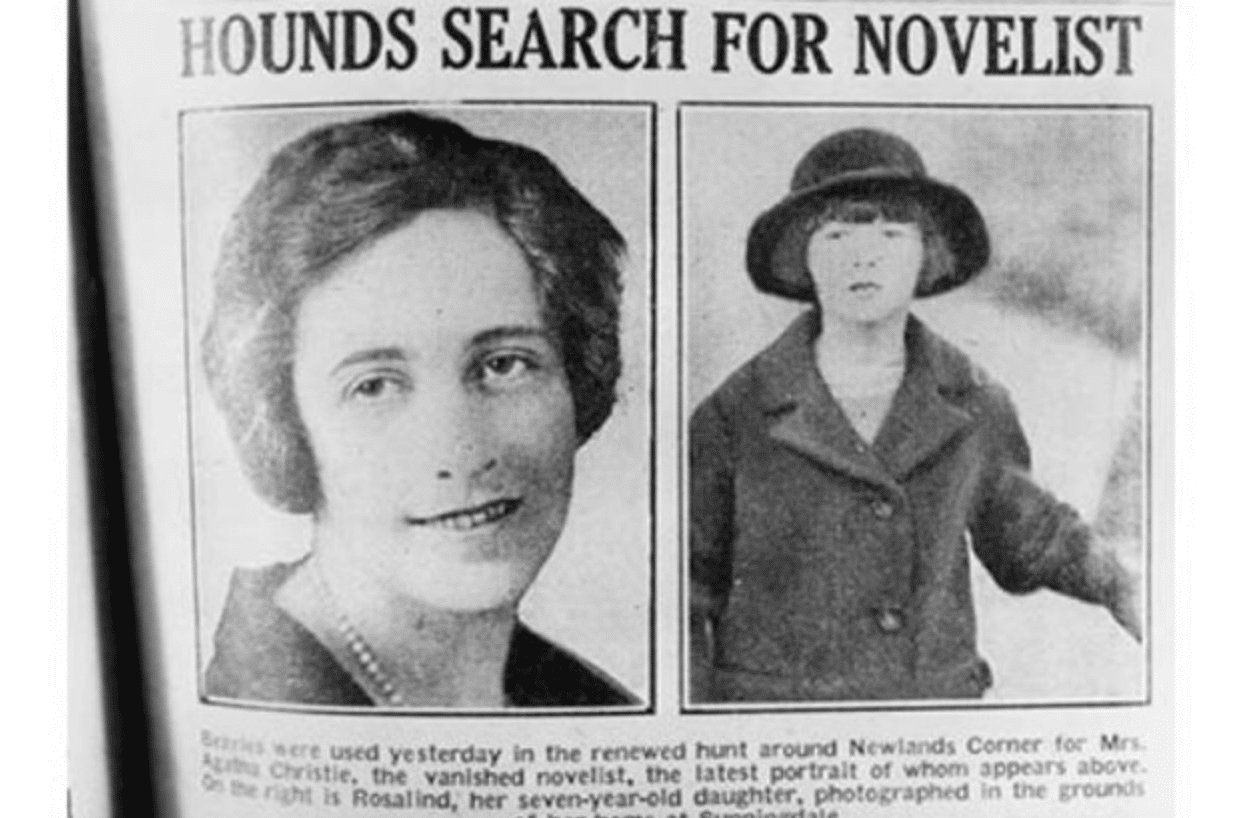
Agatha never discussed her “amnesia,” but her choice of Harrogate made perfect sense. As early as the 17th century the spa town was famous for the health benefits of its mineral-rich waters. Today the city’s public gardens and Turkish Baths (1897) still offer relaxing experiences, as does its beloved English café, Bettys. Each July, crime writers gather at The Old Swan for Harrogate’s Theakston’s Old Peculiar Crime Writing Festival
Escape to Tropical Climes
Agatha loved nothing more than going away and was utterly fearless about trying new destinations. Of her “foreign travel books,” she later would write, “if detective novels are escape literature the reader can escape to sunny skies and blue water as well as to crime in the confines of an armchair.” Balmy skies, warm water and exotic locales appear like favorite characters in her foreign travel books, along with the usual body count.
In early 1927, Agatha and her daughter Rosalind sailed for Tenerife They initially stayed at a luxury hotel in Puerto de la Cruz. Single and in need of income, Agatha got to work finishing a Poirot thriller, The Mystery of the Blue Train, set in France.
As in the days of Agatha Christie, Tenerife remains a favored destination for tourists. More than a million Brits choose Tenerife and its sister islands for their seaside vacations, enjoying sandy beaches, sailing, portside dining and wines from local vineyards. The British may order fish ‘n chips, but local specialties –octopus, cod, pork—as well as established Spanish favorites like paella and prawns are excellent. There’s great Indian fare too.

In Puerto de la Cruz, Tenerife, visitors enjoy camel rides and visits with these desert beasts, reminders that North Africa is a close neighbor to this enchanting cluster of Spanish islands. Photo by Nancy Wigston
For Christie, The Canaries—she later moved from the black volcanic beaches of Tenerife to the calm sands of Gran Canaria–were a restorative experience. Islanders have not forgotten their famous guest. Since 2007, a November Agatha Christie Festival has been held in her honor. Fans and literati gather in Puerto de la Cruz—her grandson among them—and street steps are painted with her novel titles. Calle de Agatha Christie is lined with cypress trees and gently slopes down to the blue sea.
During the biannual November festival, organizers offer tours, show films of Christie’s work, hold tea dances, and vintage car shows. Guest lecturers discuss the mystery of Christie’s enduring appeal. Says Toronto mystery writer Sylvia Warsh: “Her plots are fiendishly clever, and her deceptively simple prose makes you smile at the familiar foibles of people, especially at their propensity for gossip.”
The Canaries appear in stories about The Mysterious Mr. Quin and his friend, the equally mysterious Mr. Satterthwaite. In The Man from the Sea an elderly vacationer strolls on a Spanish island “past the black lava beach where the waves thundered and where once, long ago, a well-known English swimmer had been carried out to sea and drowned.
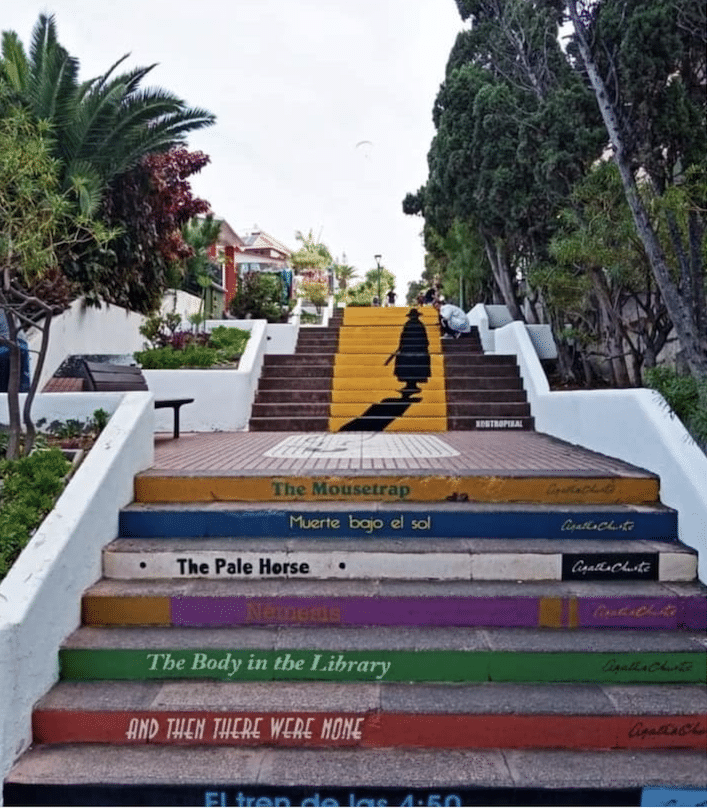
Puerto de la Cruz celebrates Agatha Christie biannually in November, but her spirit never really leaves Calle de Agatha Christie. Photo by https://canariasnatureguides.com/en_GB/
“There on the edge of a cliff, looking down-down-down to the deep blue sea below,” he encounters a young Englishman, determined to jump to his death.
Except, one hopes, for would-be suicides, visitors can walk the same path in Tenerife today.
Lushly tropical, Tenerife still pleases. The 18th century Sitio Litre Orchid Gardens offers the world’s largest collection of orchids. At Tenerife’s peak is Spain’s highest mountain, Mt. Teide. Though it looks like land best suited for Martians, this national park in an extinct volcano houses a good hotel and restaurant called Mt. Teide Parador. Meals are excellent at this government-operated parador and at night the stargazing is free.
Travels to the Ancient East
In 1929, Christie booked a tour of the West Indies. Prior to her departure, she attended a London dinner party where fellow guests regaled her with tales about ancient Ur, the Sumerian city in Mesopotamia. Canceling her Caribbean plans she booked a single seat on the luxury Orient-Express bound for Constantinople (soon to be renamed Istanbul.) From there she continued to Baghdad, eventually joining British archeologists at a desert dig.
On her second Iraqi trip, she met twenty-five-year-old archeologist Max Mallowan. He had not read any of her books but was charmed by her curiosity and spontaneity. When Agatha stripped to her underthings for a swim in the Aegean on the way back to Athens, Max joined her. They married in 1930.
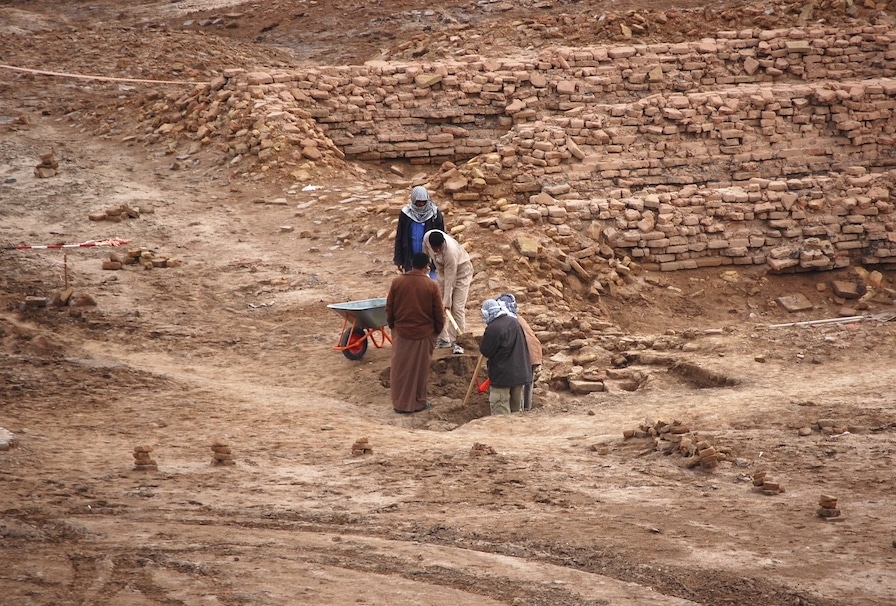
Today archaeology continues in Ur much as it did a century ago when Agatha Christie arrived in search of plots and characters. This modest excavation is funded by Italy. Photo by David DeVoss
Situated near the modern town of Nasiriya, about 365 km south of Baghdad, Ur is one of Iraq’s most impressive archeological sites. In addition to being the capital of Sumeria, it was the Prophet Abraham’s birthplace and a major trading center from 4000 BC to its destruction in the 4th century BC.
While Max and his teams unearthed gold artifacts and cuneiform tablets, Agatha gathered details for mysteries, like Murder in Mesopotamia (1935).
“The sun was just rising. The whole eastern sky was a riot of rose and orange and pale, pearly grey…The river wound away to our left and the Tell stood up outlined in gold color. To the south were the blossoming trees and the peaceful cultivation. The water wheel groaned in the distance—a faint unearthly sound. In the north were the slender minarets and the clustering fairy whiteness of Hassanieh.”
The East would form backdrops for multiple Christie mysteries. Israel, Egypt, Iraq, and Jordan all presented crimes for the internationally inclined Poirot to solve. In Appointment with Death (1938), for instance, Poirot is holidaying in Jerusalem when he overhears an odd snatch of conversation. “You do see, don’t you, that she’s got to be killed?”
His interest is further piqued when he arrives in Petra, Jordan’s “red rose city,” once home to Nabatean Arabs. Here he meets a touring party that includes the murderous plotters he overheard in Jerusalem. The Boynton family, rich Americans, have every reason to hate their Mother, who plants herself at the mouth of one Petra’s many caves, like a demonic queen.

Travelers who follow a narrow path extended about a mile through a cut in the sandstone mountains arrive at the awe-inspiring “Treasury,” the most photographed building in Petra. Harrison Ford’s quest for the Holy Grail In Indiana Jones and the Last Crusade took him to Petra’s Treasury. Photo by Nancy Wigston
Today Petra is Jordan’s pride. One of the seven wonders of the world, Petra attracts close to 1,135,000 visitors annually. Most begin their visit by attending “Petra by Night,” a candlelit two-hour event, followed by a day wandering about the giant necropolis. An astonishment of carved red rock walls greets visitors, highlighted by a columned building called the “Treasury” because it looks worthy of a city made wealthy by trade in textiles, incense, spices, and ivory.
Petra once was a thriving city with plenty of water. Nearby Wadi Rum just to the north is spectacular but empty. One Bedouin guide who gives jeep tours through this vast rock-and-desert wilderness shares stories of his grandfather, who hunted here with T. E. Lawrence (of Arabia).
Tours include a lunch grilled over hot coals and served picnic-style—something Agatha would have enjoyed. While you’re in the neighborhood, be sure to wake up with a strong Turkish coffee flavored with sugar, cardamom and cinnamon.
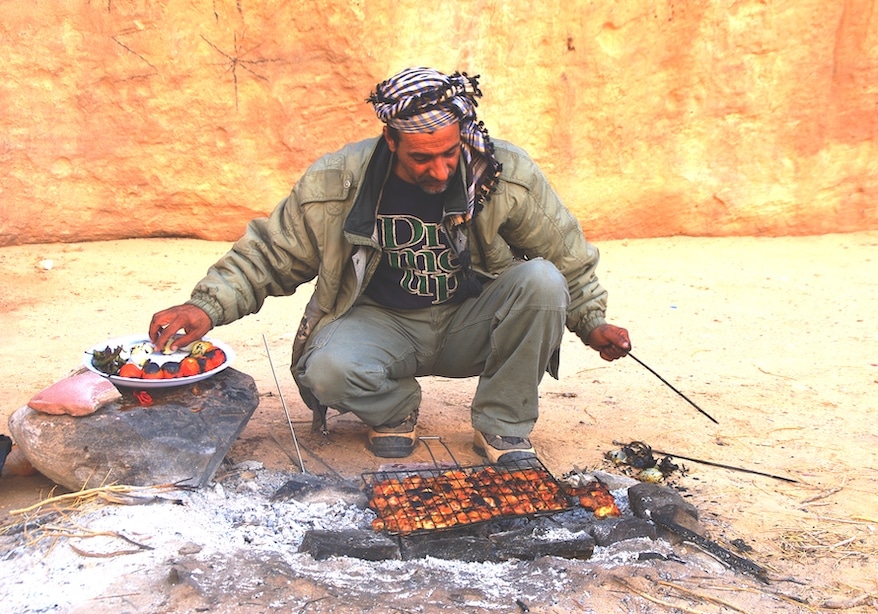
Today Wadi Rum is known for Bedouin jeep tours through the desert. But 105 years ago it served as the military headquarters of British Army Colonel T.E. Lawrence who assisted Emir Faisal in attacks on Ottoman forces. Photo by Nancy Wigston
Christie’s “foreign” novels and stories appeal to our fascination with the exotic and the criminal. Wealthy tourists frequently behave badly, travellers carry secrets along with their luggage. Her train journeys to the east charmed Agatha, and on arrival in Istanbul, she frequently stayed at her favorite hotel, the elegant Pera Palace, on the banks of the Bosphorus Strait just outside Sultanahmet, where the Blue Mosque, Hagia Sophia and Topkapi Palace are located.
A Room With A View
The belle epoque Pera Palace with its crimson and cream décor was the place to stay for illustrious and, yes, notorious travelers. Not only Agatha Christie, but Greta Garbo, Ernest Hemingway, Mata Hari and Jaqueline Kennedy are among its famous guests.
Legend has it that Agatha in Room 411 wrote Murder on the Orient Express, a tale of murder aboard a luxury train. The plot is partly based on news accounts of the same train stranded in Turkey for days by a heavy snowstorm—and partly on the Lindbergh baby kidnapping.
Today’s visitors to Istanbul can book their stay in Room 411, where management has created a kind of Christie shrine. Her portrait greets entering guests, her volumes fill bookcases and a replica of her Remington Portable sits on the desk. This grand hotel has an actual museum dedicated to Mustafa Kemal Ataturk, father of modern Turkey, who also was a frequent guest.
And in case you need a reason to pay a bit more for a night in Agatha’s room, there’s the California psychic and the case of the missing notebook. Hired by Warner Brothers in 1979 to contact the ghost of Christie, who died in 1976, the medium earned her fee by observing Agatha hiding her notebook and key in the old Istanbul hotel. A key was duly found under the floor tiles of Room 411. No notebook, however.

The walled city of Jerusalem extending out from the Temple Mount and the gold-covered Dome of the Rock mosque has changed little since Agatha Christie visited a century ago. Photo by Nancy Wigston
Agatha’s Enduring Appeal
Stories like this one together with the persistent popularity of her mysteries, ensure Christie’s continuing popularity. Midnight at the Pera Palace, a new Turkish TV series showing on Netflix, begins in Room 411. It’s 1919, and Agatha is a hotel guest but not yet a novelist. The focus is on Ataturk and the struggle for Turkish independence. A young woman journalist, coincidentally a Christie devotee, is assigned a story about the hotel’s 130th anniversary.
Staying in Room 411, she is transported back in time and voila! She finds a body in the bathroom. The period costumes and urban scenery are a treat as our young sleuth saves Ataturk from his enemies’ nefarious plotting.
Her foreign adventures complemented Christie’s rich life at home in England, where she often traveled to country estates and hotels. Interestingly, she wrote her first detective tale in a hotel in Dartmoor. The home she shared with Sir Max Mallowan, Greenway, is now a museum where fans can visit the gardens and the house and see the original frieze painted by an American serviceman during WWII.
Like the royal family, Agatha stayed in London throughout the Blitz. As the bombs fell, she churned out book after book. In her 85 years, in addition to mysteries, Dame Agatha wrote six romantic novels, two memoirs and numerous plays. The Mousetrap, closed during Covid, just announced its return to London’s West End, where it has run since 1952.
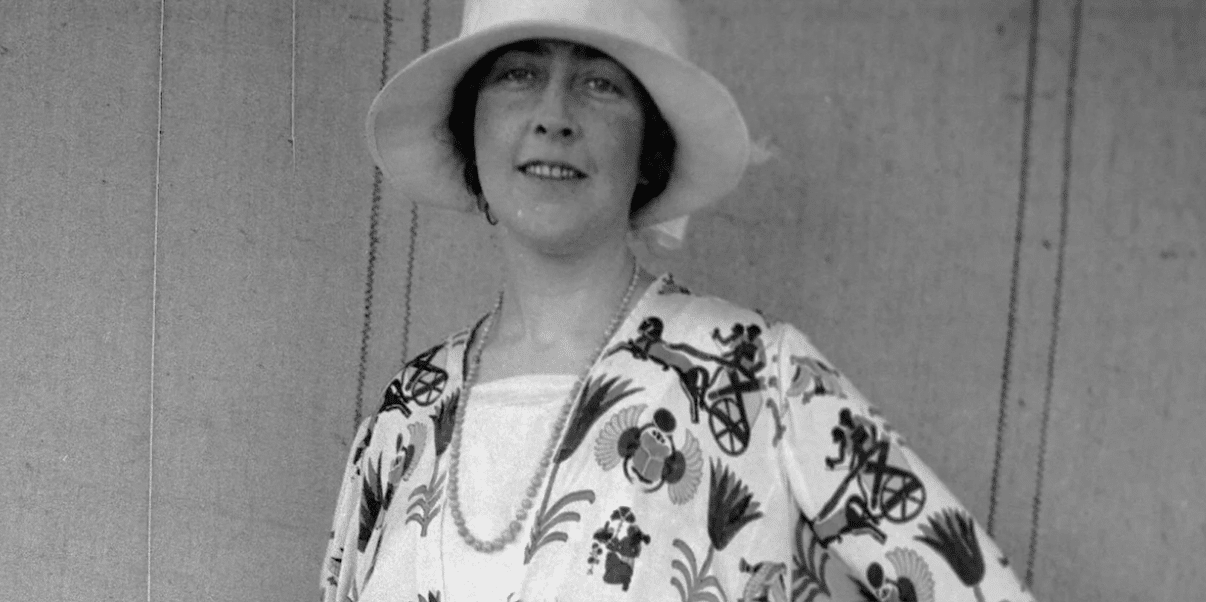
A beauty in her youth, popular at dances and house parties in her native Devonshire, Agatha launched her murder mystery career on a dare from her big sister.
Screen adaptations featuring detective Hercule Poirot and Miss Jane Marple–Agatha’s crime-solving village spinster—just keep coming. Our Covid-starved longing for travel was brilliantly satisfied by the latest Death on the Nile film, starring Kenneth Branagh as Poirot against a backdrop of Egyptian scenery and archeology. In April, the quiz show Jeopardy! featured a “Christie” category, clues supplied by actors in Why Didn’t They Ask Evans? a Brit Box series based on her 1934 mystery, with Hugh Laurie as director and star.
More than forty years after her death, Agatha Christie shows her considerable staying power: Duchess of Death, First Lady of Crime, Mistress of Mystery. And you can find her pretty much wherever you travel. ![]()
Nancy Wigston is an award-winning travel writer whose work for the East-West News Service includes stories on York, Istanbul, Buenos Aires and Uruguay.

